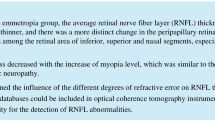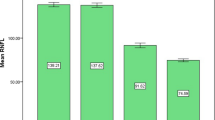Abstract
Purpose
Thinner central corneal thickness (CCT) is a risk factor for conversion from ocular hypertension to glaucoma and for disease progression. However, little is known about the relationship between CCT and characteristics of the optic nerve and the retinal nerve fibre layer (RNFL) in non-glaucomatous eyes. Because myopic eyes may pose diagnostic challenges when assessed for glaucoma, characterising the relationship between CCT and RNFL in these eyes is clinically relevant. Our aim was to investigate the relationship between CCT and RNFL thickness in non-glaucomatous eyes with small/moderate myopia.
Methods
This was a single-centre, observational, prospective, assessor-masked study. Consecutive eligible patients (myopia ≤ − 6.0 dioptres, astigmatism ≤ 2.0 dioptres) without other ocular or neurodegenerative diseases were included. Based on their CCT, the participants were allocated to group 1 (CCT > 555 μm) or group 2 (CCT < 555 μm). Peripapillary RNFL measurements were performed by a masked observer using the Spectralis OCT platform.
Results
Sixty eyes were included in group 1 and 63 in group 2. The CCT in the two groups was significantly different (584.27 ± 22.8 μm vs 522.23 ± 20.03 μm, p = 0.0001). There were no other significant differences in the groups in terms of age, refraction, or intraocular pressure. The peripapillary RNFL thickness was higher (all p < 0.005) in group 1 at several sectors: superior-temporal, inferior-temporal, inferior-nasal, and average. A significant positive correlation between CCT and average RNFL thickness was found for the whole population (r = 0.31, p = 0.0001).
Conclusion
Otherwise, healthy myopes with thinner CCT have thinner RNFL compared with participants of similar age and refraction with thicker CCT.
Similar content being viewed by others
Data availability
Data were registered in the patients’ medical record.
References
Marcus MW, de Vries MM, Junoy Montolio FG, Jansonius NM (2011) Myopia as a risk factor for open-angle glaucoma: a systematic review and meta-analysis. Ophthalmology 118:1989–1994.e2
Ren R, Wang N, Li B et al (2009) Lamina cribrosa and peripapillary sclera histomorphometry in normal and advanced glaucomatous Chinese eyes with various axial length. Invest Ophthalmol Vis Sci 50:2175–2184
Burgoyne CF, Downs JC, Bellezza AJ, Suh J-KF, Hart RT (2005) The optic nerve head as a biomechanical structure: a new paradigm for understanding the role of IOP-related stress and strain in the pathophysiology of glaucomatous optic nerve head damage. Prog Retin Eye Res 24:39–73
Czudowska MA, Ramdas WD, Wolfs RCW et al (2010) Incidence of glaucomatous visual field loss: a ten-year follow-up from the Rotterdam Study. Ophthalmology 117:1705–1712
Tan NYQ, Sng CCA, Jonas JB, Wong TY, Jansonius NM, Ang M (2019) Glaucoma in myopia: diagnostic dilemmas. Br J Ophthalmol 103:1347–1355
Hoffmann EM, Schmidtmann I, Siouli A et al (2018) The distribution of retinal nerve fiber layer thickness and associations with age, refraction, and axial length: the Gutenberg health study. Graefes Arch Clin Exp Ophthalmol 256:1685–1693
Seo S, Lee CE, Jeong JH, Park KH, Kim DM, Jeoung JW (2017) Ganglion cell-inner plexiform layer and retinal nerve fiber layer thickness according to myopia and optic disc area: a quantitative and three-dimensional analysis. BMC Ophthalmol 17:22
Lan Y-W, Chang S-Y, Sun F-J, Hsieh J-W (2019) Different disc characteristics associated with high myopia and the location of glaucomatous damage in primary open-angle glaucoma and normal-tension glaucoma. J Glaucoma 28:519–528
Xu X-Y, Xiao H, Luo J-Y, Liu X (2019) Evaluation of spectral domain optical coherence tomography parameters in discriminating preperimetric glaucoma from high myopia. Int J Ophthalmol 12:58–65
Ang M, Wong CW, Hoang QV et al (2019) Imaging in myopia: potential biomarkers, current challenges and future developments. Br J Ophthalmol 103:855–862
Kim MJ, Lee EJ, Kim T-W (2010) Peripapillary retinal nerve fibre layer thickness profile in subjects with myopia measured using the Stratus optical coherence tomography. Br J Ophthalmol 94:115–120
Aung T, Foster PJ, Seah SK et al (2001) Automated static perimetry: the influence of myopia and its method of correction. Ophthalmology 108:290–295
Gordon MO, Beiser JA, Brandt JD et al (2002) The Ocular Hypertension Treatment Study: baseline factors that predict the onset of primary open-angle glaucoma. Arch Ophthalmol 120:714–720 discussion 829–830
European Glaucoma Prevention Study (EGPS) Group, Miglior S, Pfeiffer N, Torri V et al (2007) Predictive factors for open-angle glaucoma among patients with ocular hypertension in the European Glaucoma Prevention Study. Ophthalmology 114:3–9
Zhang X, Parrish RK, Greenfield DS et al (2019) Predictive Factors for the Rate of Visual Field Progression in the Advanced Imaging for Glaucoma Study. Am J Ophthalmol 202:62–71
Chan TCW, Bala C, Siu A, Wan F, White A (2017) Risk factors for rapid glaucoma disease progression. Am J Ophthalmol 180:151–157
Konstas AGP, Irkec MT, Teus MA et al (2009) Mean intraocular pressure and progression based on corneal thickness in patients with ocular hypertension. Eye (Lond) 23:73–78
Kaushik S, Gyatsho J, Jain R et al (2006) Correlation between retinal nerve fiber layer thickness and central corneal thickness in patients with ocular hypertension: an optical coherence tomography study. J Ophthalmol 141:884–890
Author information
Authors and Affiliations
Contributions
Esther Arranz-Marquez: design of the work, interpretation of data, writing and revision of the original draft, approval of the final version. Gorka Lauzirika: data acquisition, analysis of data, writing of original draft, approval of the final version. Miguel A. Teus: conception and design of the work, analysis and interpretation of data, revision of original draft, approval of the final version. Andreas Katsanos: design of the work, interpretation of data, writing and revision of the original draft, approval of the final version
Corresponding author
Ethics declarations
Conflict of interest
Esther Arranz-Marquez declares that she has no conflict of interest.
Gorka Lauzirika declares that he has no conflict of interest.
Miguel A Teus receives honoraria from Alcon, Santen, Allergan, Johnson & Johnson Vision, Glaukos, and Care Group; and research grant from Johnson & Johnson Vision and Alcon.
Andreas Katsanos receives honoraria/congress expenses from Santen, Vianex, Laboratoires Théa, and Cooper SA; and research grant from Laboratoires Théa.
Ethics approval
Approval was obtained from the ethics committee of Investigación Clínica Regional de la Comunidad de Madrid (CEIC-R) (ID 216/03). The procedures used in this study adhere to the tenets of the Declaration of Helsinki.
Consent to participate
Informed consent was obtained from all individual participants included in the study.
Consent for publication
Not applicable.
Additional information
Publisher’s note
Springer Nature remains neutral with regard to jurisdictional claims in published maps and institutional affiliations.
Rights and permissions
About this article
Cite this article
Arranz-Marquez, E., Lauzirika, G., Teus, M.A. et al. Thinner retinal nerve fibre layer in healthy myopic eyes with thinner central corneal thickness. Graefes Arch Clin Exp Ophthalmol 258, 2477–2481 (2020). https://doi.org/10.1007/s00417-020-04873-8
Received:
Revised:
Accepted:
Published:
Issue Date:
DOI: https://doi.org/10.1007/s00417-020-04873-8




